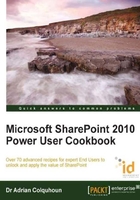
What this book covers
This book is presented in eight chapters and an appendix covering the following areas:
Chapter 1: Getting Started—SharePoint Essential focuses on SharePoint 2010 fundamentals, including creating and using your My Site, tracking colleagues, bookmarking sites, registering for alerts, and using themes to change how SharePoint looks and feels. Recipes are provided that show you how to create columns, lists, content types, and how to secure information on a SharePoint 2010 site.
Chapter 2: Working Together—Using SharePoint to Collaborate explores the tools that allow you to use SharePoint 2010 to work more effectively. It shows you how to create a Team Site and add users to it. You will learn how to create a shared calendar for important events and a shared task list to keep track of your team's tasks. You will see how to manage the calendar and tasks using Outlook 2010. You will learn how to use the site to gather feedback using a discussion forum and how to share PowerPoint slides using a slide library.
Chapter 3: SharePoint as the Data Hub—Storing and Integrating Data is all about storing and integrating data in SharePoint 2010. It covers storing data directly in SharePoint, using custom lists, and so on. It shows you how to include data from an external database using external content types and how to include common terms in the managed metadata store. Important list concepts are covered including creating list views and columns based on metadata.
Chapter 4: SharePoint Document Management Deep Dive explores document management in SharePoint 2010. You will learn how to upload and download documents and use the document management features such as versioning, "check in/check-out", publishing, and content approval. You will see how to take your documents offline using Outlook 2010. You will see how to use content types to store different types of documents in the same document library. You will learn how the new co-authoring features allow multiple authors to work on the same document at the same time.
Chapter 5: Getting the Message Out—Using SharePoint to Communicate focuses on SharePoint 2010's communication features. It explains how to create a blog on your My Site and how to post to that blog from Word 2010. It shows how to create and publish web pages in a publishing site, how to use announcements to communicate important news, and how to use audiences to target your messages to the right people.
Chapter 6: Where's My Stuff?—Finding Things with SharePoint is all about using SharePoint's search facility. It shows how to use basic and advanced searches to find documents, information, and people. It shows how to save your searches as alerts so that you will automatically be notified if the results change.
Chapter 7: Gaining Insights—Using SharePoint for Business Intelligence explains the business intelligence capabilities of SharePoint 2010. It shows you how to create master/detail views of SharePoint data and how to create Key Performance Indicators. The creation of charts is illustrated using the built-in Chart Web Part and the PerformancePoint Dashboard Designer. Reports are created using the Report Builder tool, and Excel Services is used to run spreadsheets directly on the SharePoint server.
Chapter 8: Automating Business Processes—Recipes for Electronic Forms and Workflows examines SharePoint's electronic forms and workflow capabilities. Recipes are included that provide a deep dive into InfoPath 2010 and the electronic forms technology included in SharePoint Server. You will learn how to use the Collect Feedback workflow to receive feedback on a document that you have authored. You will see how to create custom workflows using Microsoft Visio 2010 and SharePoint Designer 2010. You will learn how to view a workflow's current execution status, its execution history, and how to start SharePoint 2010 workflows directly from inside a Word 2010 document.
Appendix: Joining the Dots—Creating Composite Applications draws together all the recipes presented early in the book to create three "no code" SharePoint 2010 applications. These simple Human Resources, Customer Relationship Management, and Project Management solutions build upon and reinforce the concepts presented earlier in the book. The purpose of this chapter is to teach you how to "think SharePoint", applying the knowledge and tools you have gained to solve real business problems in the future.